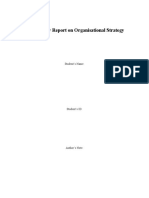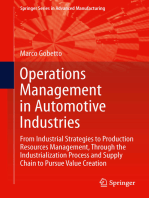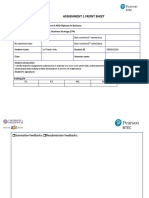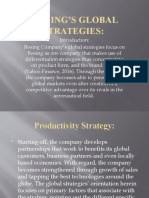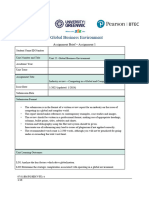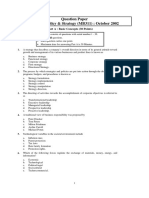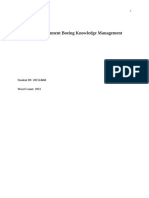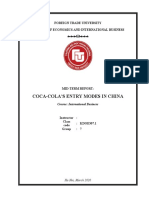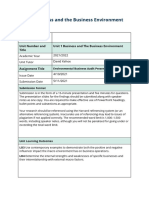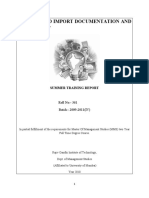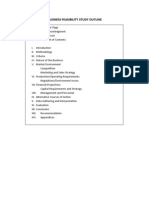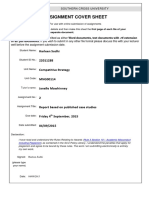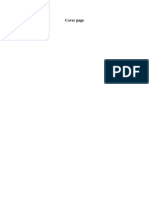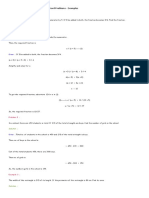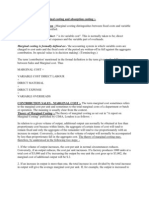Marketing Audit
Marketing Audit
Uploaded by
psivathmikaCopyright:
Available Formats
Marketing Audit
Marketing Audit
Uploaded by
psivathmikaCopyright
Available Formats
Share this document
Did you find this document useful?
Is this content inappropriate?
Copyright:
Available Formats
Marketing Audit
Marketing Audit
Uploaded by
psivathmikaCopyright:
Available Formats
MARKETING AUDIT OF BOEING
Masters in Business Administration ACADEMIC ASSESSMENT SUBMISSION FORM STUDENT NUMBER MODULE CODE MODULE TITLE LECTURER NAME DUE DATE SUBMISSION DATE ASSESSMENT TASK WORD COUNT GRADE In submitting this work, I confirm that I have understood UHI regulations relating to plagiarism, and that: I have completed this assigned work by myself, in my own words and using my own notes, figures or rough workings (except where group work specifically forms part of the assignment) I have acknowledged fully any sources used by means of in-text citations, and the creation of a List of References in the UHI approved system of Harvard referencing 1310 STRATEGIC MARKETING MS. JILL ELDER 3.3.2014 3.3.2014 10011165
10011165
Page 1
MARKETING AUDIT OF BOEING
system I have endeavoured to ensure that my work has not been made available for copying by other students (with or without my permission) I have submitted a soft copy to Turnitin through the JISC plagiarism software and provided a soft copy of the report with my submission to the Gradebook in Blackboard. I have submitted a soft copy to the Gradebook in Blackboard.
In submitting this work for assessment, I agree to be bound by the conditions laid out above, and by the latest version of the UHI academic regulations. UHI REGULATIONS Plagiarism: unacknowledged incorporation in a students work either in an examination or assessment of material derived from the work (published or unpublished) of another. Plagiarism may therefore include: the use of another persons material without reference or acknowledgement the summarising of another persons work by simply changing a few words or altering the order of presentation without acknowledgement the use of the ideas of another person without acknowledgement of the source copying of the work of another student with or without that students knowledge or agreement use of commissioned material presented as the students own.
PLEASE ATTACH THIS FORM TO THE FRONT OF YOUR ASSESSMENT SUBMISSION
10011165
Page 2
MARKETING AUDIT OF BOEING
Table of Contents
INTRODUCTION ............................................................................................................................................. 4 BACKGROUND OF BOEING ............................................................................................................................ 4 MARKETING AUDIT ....................................................................................................................................... 6 1. 2. 3. EXTERNAL ENVIRONMENT ................................................................................................................ 6 COMPETITIVE ENVIRONMENT .......................................................................................................... 8 MARKETING ENVIRONMENT............................................................................................................. 9
INTERNAL AUDIT ......................................................................................................................................... 11 SWOT ANALYSIS ...................................................................................................................................... 12 EVALUATION OF CURRENT MARKETING STRATEGY ................................................................................... 12 CONCLUSION............................................................................................................................................... 13 GLOSSARY.................................................................................................................................................... 14 APPENDIX 1 ................................................................................................................................................. 14 APPENDIX 2 ................................................................................................................................................. 17 BIBLIOGRAPHY ............................................................................................................................................ 18
10011165
Page 3
MARKETING AUDIT OF BOEING
INTRODUCTION
In the competitive world, almost all companies try to sell their product by setting marketing strategies or marketing plan. The marketing plan is designed to achieve the marketing objectives that are set by the organization to meet the organizational goals (The Times 100 Business Case Studies 2014). In order to review the marketing plan and the marketing activities, marketing audit is performed on a regular basis (Kamil 2012; R.M.S.Wilson 2004). This report deals with the marketing audit of Boeing, a US based aircraft manufacturing company. Through marketing audit, external and internal environment changes of the organisations are critically analysed by using informations from books, journals, articles, reports, newspapers and web sources. Moreover, scenario planning is carried out to understand the various consequences arise due to the change in the external environment and their impacts are critically evaluated to review Boeings current marketing strategy. In addition, some models: PESTEL, Porter five forces, and SWOT analysis are used to understand the changing environment. The report is finally concluded by evaluating the current marketing strategy of Boeing.
BACKGROUND OF BOEING
Boeing is a traditional aerospace company founded in 1916 by W.Boeing (W.Gould 1995). Since then Boeing faced many challenging environment to become one of the leading aircraft manufacturing companies in the aerospace industry (Boeing 2014). Boeing has a diversified market; hence, to become a leader of the concern market, Boeing divided its business in to two namely commercial airplane manufacturer and
10011165 Page 4
MARKETING AUDIT OF BOEING
defense, space and security aircraft manufacturer (Boeing 2013). However, this report focuses only on the commercial aviation sector. The marketing objective of Boeing is to sell fuel-efficient and high performance aircraft to its customers namely premium and low cost airlines. Since aircraft manufacturing involves too much cost and work force, Boeing follows marketing strategy of selling before manufacturing the product (W.Gould 1995) that allows the company to analyse market demand of that product, understands customer opinion, and make feasible changes according to the customer requirements. Moreover, Boeing delivers various types of aircrafts and services to their customers in 150 countries (Boeing 2014). About 70% of Boeing revenue is mainly from the operators outside US, hence Boeing concentrates more on its global market (Boeing 2014). Boeing believes in service after sales marketing strategy to maintain the loyalty of the international customers (W.Gould 1995). However this is an old strategy of Boeing, innovations are introduced to make the strategy effective to the recent world. For instance, Boeing set up a Boeing Commercial Aviation Service, which works 24 hours to provide technical support, material and other services to its operators around the world that outweighs Boeing from other competitors (Boeing 2013). These marketing strategies are critically reviewed regularly via marketing audit to implement any changes in the marketing plan in order to achieve the marketing objectives. The marketing audit of Boeing is further explained in detail.
10011165
Page 5
MARKETING AUDIT OF BOEING
MARKETING AUDIT
Marketing audit checks optimum and efficient use of company resources against the market demand. Marketing audit consists of internal audit and external audit to understand the changing environment that has an impact on marketing strategy (The Charted Institute of Marketing n.d). The external audit covers micro and macro environment of the organisation by focusing on three factors that are analysed by various models such as 1. External environment of organization- PESTEL analysis 2. Competitive Environment Porter five forces and 3. Market environment Moreover, scenario planning of external and competitive environment is discussed further in this topic.
1. EXTERNAL ENVIRONMENT
The External environment of the organistion should be considered to minimize the impact of risk in selling the products in future and also to foresee the opportunities in expanding the business globally. The main PESTEL factors that has an impact on the companys marketing plan are Political, Economy and Technological factors. Social, environment and legal have less impact; hence, these are discussed in Appendix 1
10011165
Page 6
MARKETING AUDIT OF BOEING
POLITICAL: The strategy of expanding the business globally is affected by the WTO restrictions (World Trade Organisation 2011). Therefore, Boeing should find an alternative source of entry in to the market of restricted country. For example, instead of a direct entry Boeing can enter in to that market through alliance policy or negotiating mutual beneficial trade agreement with that country. Hence, Boeing can deliver its product even in the non-free trade countries. ECONOMIC: Boeing has a promising future economy with its long-term demand of 35,280 aircrafts that has a value of $4.8 trillion (Boeing 2013). Hence, on the basis of current marketing strategy Boeing managed to be successful leader of the aviation market. However, Boeing experience recent disputes in getting government subsidies (World Trade Organisation 2011). This results in manufacturing delays, which in turn affect the on time delivery of the aircrafts. Moreover, insufficient funds may affect the marketing strategy of producing customer-oriented products. TECHNOLOGY Through technology, Boeing not only maintains the stronger global network but also improvise its marketing strategy by implementing new innovations in the products as well as in the service. For instance introducing 24-hour technical support to the operators made Boeing user-friendly organisation. Moreover, by manufacturing new lighter and fuel efficient aircrafts enhances the market demand.
10011165
Page 7
MARKETING AUDIT OF BOEING
SCENARIO PLANNING Airbus complained to the WTO about Boeing regarding the usage of US government military subsides in the commercial aviation research and development. If Boeing failed to get the government subsidies, it will experience major problem in commercial market and will greatly affect the quality of product and service. Hence, Boeing should find an alternate source for the funds and also implement new marketing strategy to increase the market demand of the existing products.
2. COMPETITIVE ENVIRONMENT
Analysing the competitive environment is mandatory to maintain the competitive advantage of organisation. Hence, this is analysed with the help of porter five forces as follows PORTER FIVE FORCES In this only the major force that affect the marketing plan are discussed and remaining are mentioned in Appendix 2 Boeing has high rivalry in the market because of the European aircraft manufacturer Airbus. Hence, this lead to the higher buyer power. Since Boeing and Airbus produce almost same products, airlines can switch to any organisation. In order to maintain the competitive advantage, Boeing uses service after sales marketing strategy to differentiate its service from the competitors (W.Gould 1995).
10011165
Page 8
MARKETING AUDIT OF BOEING
However, buyer power may vary because of the type of airline. Low cost airline will try to have one type of aircraft to reduce maintenance and training costs and also the requirement of seating capacity is distinct hence they do not have much options in selecting manufacturer.
3. MARKETING ENVIRONMENT
Boeing is in a growing market environment since 1990 to 2010 that can be seen from the figure 1, which shows revenue of passengers per kilometer (RPK). Moreover, figure 2 depicts increase in aircraft demand in developing countries due to the introduction of low cast airlines and change in the socio culture in that country. Hence, Boeing has growing market with higher product demand.
Figure 1: Aviation Market trend since 1990 to 2010 (Boeing 2013)
10011165
Page 9
MARKETING AUDIT OF BOEING
Figure 2: Demand by region of Boeing (Boeing 2014) However, Boeing has less market demand in some regions such as Europe, Latin America and therefore gained less profit in the year 2012 in those regions (Refer figure 3). Moreover, the figure also explains the strength of the Boeing that is Asia Pacific region. Hence, Boeing should overcome the weakness by adapting new marketing strategy and also improvise the existing strategy to maintain the customer loyalty.
10011165
Page 10
MARKETING AUDIT OF BOEING
Figure 3: Regional Profitability Outlook (Boeing 2013).
INTERNAL AUDIT
The organisation should know its strength and weakness to sustain in the competitive market. Moreover should use the opportunities arose due to the changing environment and take prior actions to reduce the impact of future threats. To understand all these factors and to improvise the organizations marketing activities internal audit is carried out. The internal audit of Boeing can be easily performed through SWOT analysis, which is further discussed
10011165
Page 11
MARKETING AUDIT OF BOEING
SWOT ANALYSIS
Through this analysis company will understand its position in the market and steps to be taken to prevent the risk factors. Since main revenue of Boeing lies in the international customers, Boeing maintains close relationship with global customers through conference, annual meet and providing various services. At present lack of funding from the government is main weakness in expansion of the business. Skilled staff and technology provide great opportunity in marketing activities. The main threat of Boeing is various suppliers, if one supplier faces a problem then that affects the whole manufacturing process. For instance, the recent delay in the delivery of B777 and B787 is due to the Japan Earth quake since 35% of the parts are manufactured in Japan (Chicago Tribuue 2013). Hence, Boeing should take necessary actions to prevent these risks.
EVALUATION OF CURRENT MARKETING STRATEGY
By considering the future market demand, current marketing strategy is well in force. However, improvisation of marketing strategy is required to maintain the loyalty of the global customers such as introducing R&D in all the countries. Moreover, the unavailability of government funding is a major problem of Boeing as far now, hence improvisation of marketing strategy is mandatory to sell the existing products and thereby increase the revenue of the organisation.
10011165
Page 12
MARKETING AUDIT OF BOEING
CONCLUSION
On the whole, the marketing strategy used by Boeing is reviewed to understand the effectiveness of the marketing plan. The marketing audit can be concluded by saying that the current marketing strategies are good; however, improvisation of marketing strategy is required to overcome the weakness and enhance the competitive advantage. Moreover, new marketing strategies should be implemented to compete the economic fluctuations that is to take more orders to reduce the manufacturing cost.
10011165
Page 13
MARKETING AUDIT OF BOEING
GLOSSARY
US- UNITED STATES of AMERICA R&D- RESEARCH AND DEVELOPMENT PROGRAMME
APPENDIX 1
PESTEL ANALYSIS OF BOEING
10011165 Page 14
MARKETING AUDIT OF BOEING
POLITICAL The support or interventions of the government affect the buying of the aircrafts. For instance, China being major market of Boeing using about 700 Boeing aircrafts decides to be a loyal customer for the next twenty years (Boeing 2009). This allows the China government to gain a political leverage in U.S. and hence increase the opportunity of trading more in China. World Trade Organisation (WTO) has great impact on the Boeings decision of expanding globally. WTO allows Boeing to have successful negotiation of mutually beneficial trade agreements with international countries (Boeing 2009). However, WTO also restricts Boeing in trading with other countries due to the countries trade restriction policy. ECONOMIC Favoring Exchange rates Dispute in Government subsidies has great impact on the economy of the organization (World Trade Organisation 2011). Increase in fuel price made the airlines to demand for the fuel-efficient aircrafts. Hence, Boeing should invest more in research and development of new aircrafts that are fuel-efficient. SOCIO CULTURAL According to International Air Transport Association survey, many business travelers prefer economic class rather than business class seats. Hence major
10011165
Page 15
MARKETING AUDIT OF BOEING
income of the airline lies on the business travelers, the airlines demands for more economic seating aircrafts and therefore Boeing featured a new aircraft with a different seating configuration and calling that class as Premium economy class (C.Taylor 2010). Thus, Boeing manufactures the aircraft according to the customer requirement. TECHNOLOGY Technology is main driving force of Boeing, Boeing spend millions of dollars in research and development of new technologies. The use of 50% composites in its new 787 Dreamliner becomes a breakthrough in the aviation market (Brosius 2007). Moreover, actively collaborate with other institution and universities to innovate new technologies that can differentiate its product from competitors. Thus strengthens the market position of Boeing. ENVIRONMENT Boeing always manufactures aircraft that consumes less fuel that in turn emit less carbon dioxide. Boeing uses its technology factor to reduce the carbon footprints and more over support the research process of finding alternate fuel for the aircraft. LEGAL Since Boeing is a part of aviation market, it is bound to follow the required standards set by Federal Aviation Administration in manufacturing the products. However, this has a least impact in the selling of the product.
10011165 Page 16
MARKETING AUDIT OF BOEING
APPENDIX 2
PORTER FIVE FORCES 1. Barriers to Entry - Analysis=High New airplanes and engines require extremely high investments accompanied with great risk and the inability to get a positive return on that investment for many years. Aerospace industry requires large amounts of continuous investment in research and development due to the complexity of the industry. 2. Supplier Power -Analysis=Weak Firms in the aerospace industry have several supplier which to choose from. Boeing has round 22,000 suppliers Globally (Boeing 2014).
3. Buyer Power - Analysis=High Airlines are cutting their investments, which forces a deadly competition in the aircraft industry. Due to the competition, Buyers (Airlines) force advantageous reductions in the price of Aircrafts. Aerospace firms compete for large orders from airlines to try to recover their high costs 4. Threat of Substitutes - Analysis=Weak The ability of aircraft covering large distance in a shorter duration of time being a deciding factor in choosing the air journey. Hence, almost no substitutes for long haul aircrafts.
10011165
Page 17
MARKETING AUDIT OF BOEING
Exception: for short distances over land, aircrafts may compete against automobiles and trains. 5. Competitive rivalry - Analysis= High Two firms competing in the Aircraft industry, Boeing and Airbus. The two firms are equally balanced and have little differentiation in their products.
BIBLIOGRAPHY
Boeing (2009) Boeing's Right There [11 Febraury 2014]
10011165
Page 18
MARKETING AUDIT OF BOEING
Boeing (2013) About Us: Commercial Airplanes [online]. Available from <http://www.boeing.com/boeing/companyoffices/aboutus/brief/commercial.page?> [ November 2013] Boeing (2013) Current Market Outlook 2013-2032 [ February 2014] Boeing (2014) The Boeing Compnay Overview [ 15 2014] Brosius, D. (2007) B787 Update [online]. Available from <http://www.compositesworld.com/articles/boeing-787-update> [ Febraury 2014] C.Taylor (2010) Putting Premium on Economy [online]. Available from <http://www.boeing.com/Features/2010/05/bca_premium_on_economy_05_03_10.html> [20 Febraury 2014] Chicago Tribuue (2013) Boeing Production in Japan [online]. Available from <http://articles.chicagotribune.com/2013-11-12/business/chi-mitsubishi-boeing-777x-wing-offer20131112_1_787-dreamliner-boeing-workers-mitsubishi-heavy-industries-ltd> [ Febrary 2014] Kamil, L. (2012) Marketing Audit as a Method of the Evaluation of the Marketing Plan [15 February 2014] P. Kotler, W.T.G. & Rodgers, W.H. (1989) 'The Marketing Audit Comes of Age.' MIT Solan Management Review [12 Febraury 2014] R.M.S.Wilson, C.G. (2004) Strategic Marketing Management 3rd edn. Oxford: Taylor & Francis Ltd The Charted Institute of Marketing (n.d) Marketing Audit [online]. Available from <http://www.cim.co.uk/marketingplanningtool/tech/tech5.asp> [9 Febraury 2014] The Times 100 Business Case Studies (2014) 'Marketing Theory.' The Times 100 Business Case Studies [5 February 2014] Tybout, A.M. & Hauser, J.R. (2001) 'Marketing Audit.' Journal of Marketing 45(3), a2101 [10 February 2014] W.Gould (1995) Business in Action Boeing. Avon: Cherrytree Press World Trade Organisation (2011) WTO Issues Panel Report on Boeing Dispute [online]. Available from <http://www.wto.org/english/news_e/news11_e/353r_e.htm> [16 Febraury 2014]
10011165
Page 19
MARKETING AUDIT OF BOEING
10011165
Page 20
You might also like
- BOEING - A Case Study On JIT and Lean OperationsDocument13 pagesBOEING - A Case Study On JIT and Lean OperationsCandy Anne Patoc67% (6)
- Business Analysis and Communication Strategy of BoeingDocument11 pagesBusiness Analysis and Communication Strategy of BoeingMuhammad Sajid Saeed0% (1)
- Consultancy Report On Organisational StrategyDocument24 pagesConsultancy Report On Organisational StrategyHorizonv4No ratings yet
- Operations Management in Automotive Industries: From Industrial Strategies to Production Resources Management, Through the Industrialization Process and Supply Chain to Pursue Value CreationFrom EverandOperations Management in Automotive Industries: From Industrial Strategies to Production Resources Management, Through the Industrialization Process and Supply Chain to Pursue Value CreationNo ratings yet
- Financial Management: Boeing Case StudyDocument14 pagesFinancial Management: Boeing Case StudyJamie Lucas100% (1)
- Marketing Plan: F&F ClothingDocument14 pagesMarketing Plan: F&F ClothingMuhammad Faraz HasanNo ratings yet
- Sample 3Document27 pagesSample 3Rohana HasanNo ratings yet
- Assignment 1 Front SheetDocument12 pagesAssignment 1 Front SheetDinh DoNo ratings yet
- Home DepotDocument8 pagesHome DepotRajesh KumarNo ratings yet
- Credit Monitoring and Follow-Up: MeaningDocument23 pagesCredit Monitoring and Follow-Up: Meaningpuran1234567890100% (2)
- Analysis of Boieng AirlineDocument8 pagesAnalysis of Boieng AirlineThai CelineNo ratings yet
- Cuegis BoeingDocument3 pagesCuegis BoeingAhmed ShahwanNo ratings yet
- Strategic MaNagement AssignmentDocument16 pagesStrategic MaNagement AssignmenttinoNo ratings yet
- Marketing Essentials - Primark Fashion Retailer OperatingDocument25 pagesMarketing Essentials - Primark Fashion Retailer OperatingZamzam AbdelazimNo ratings yet
- Strategic Management and Strategic Competitiveness: Knowledge ObjectivesDocument23 pagesStrategic Management and Strategic Competitiveness: Knowledge ObjectivessuriakumaranNo ratings yet
- Entrep Module 3Document7 pagesEntrep Module 3Rover NoayNo ratings yet
- Boeing's Global StrategiesDocument12 pagesBoeing's Global StrategiesPeter Mulwa100% (1)
- Unit 25: Global Business Environment: Assignment Brief - Assignment 1Document16 pagesUnit 25: Global Business Environment: Assignment Brief - Assignment 1duyhhagbs210636No ratings yet
- 5 C Analysis PEST Analysis SWOT AnalysisDocument4 pages5 C Analysis PEST Analysis SWOT Analysisavisekghosh2015No ratings yet
- (Ifta) Kiril Sirm Bs (13!12!20)Document24 pages(Ifta) Kiril Sirm Bs (13!12!20)Rahiana AminNo ratings yet
- Ent530 - Business Plan - Guidelines & TemplateDocument16 pagesEnt530 - Business Plan - Guidelines & Templateafiqah100% (1)
- MKT3040 AS1 - Tran Hong Anh - 24833177Document11 pagesMKT3040 AS1 - Tran Hong Anh - 24833177Hồng Anh TrầnNo ratings yet
- Assignemnt 1 Brief From Jan 2024Document6 pagesAssignemnt 1 Brief From Jan 2024hoangnnngbs220355No ratings yet
- 0210 BPS (MB331)Document16 pages0210 BPS (MB331)Shravan WadhwaNo ratings yet
- RAPDocument48 pagesRAPRohail Amjad100% (1)
- Porter Five Forces ThesisDocument9 pagesPorter Five Forces Thesisdothakellersiouxfalls100% (2)
- MB0046Document13 pagesMB0046sumit86No ratings yet
- Marketing ExamDocument6 pagesMarketing ExamAdriana ClarkeNo ratings yet
- Article Review: FIRM RESPONSE STRATEGY UNDER GLOBALIZATION IMPACT IN HI-TECH & KNOWLEDGE-INTENSIVE FIELDS.Document6 pagesArticle Review: FIRM RESPONSE STRATEGY UNDER GLOBALIZATION IMPACT IN HI-TECH & KNOWLEDGE-INTENSIVE FIELDS.Hairul MusliminNo ratings yet
- Marketing PrincipleDocument11 pagesMarketing PrincipleamalhameedNo ratings yet
- Strategic Analysis of Apple Inc.Document13 pagesStrategic Analysis of Apple Inc.Muhammad Sajid Saeed100% (7)
- Financial Statement Analysis ExercisesDocument37 pagesFinancial Statement Analysis ExercisesMirza Zahidul AlamNo ratings yet
- Strategic Planning and Implementation & Strategic Marketing ManagementDocument16 pagesStrategic Planning and Implementation & Strategic Marketing Managementyuvraj9898No ratings yet
- UOL19Document21 pagesUOL19reonpeter1No ratings yet
- Product Development - Apple Vs GoogleDocument14 pagesProduct Development - Apple Vs GoogleFelix BöhmeNo ratings yet
- Marketing Management Case: Boeing: Lincoln UniversityDocument10 pagesMarketing Management Case: Boeing: Lincoln Universitymihajlo88No ratings yet
- Report On Coca-Cola's Entry Modes in ChinaDocument15 pagesReport On Coca-Cola's Entry Modes in ChinaMai TrinhNo ratings yet
- Boeing Report FinalDocument20 pagesBoeing Report FinalSiti AfiqahNo ratings yet
- Unit 1: Business and The Business Environment: Assignment BriefDocument4 pagesUnit 1: Business and The Business Environment: Assignment BriefNguyễn Quốc AnhNo ratings yet
- Ashebir I.B.M AssignmentsDocument12 pagesAshebir I.B.M AssignmentsAmmanNo ratings yet
- Unit 7Document8 pagesUnit 7Muhammad ShoaibNo ratings yet
- MODULE 2 Project Identification & PreparationDocument13 pagesMODULE 2 Project Identification & PreparationJhonmark MendozaNo ratings yet
- PD3 Case Study November 2016Document20 pagesPD3 Case Study November 2016Anonymous 8ayfd1HmNo ratings yet
- WilliamsDocument28 pagesWilliamsTony DumfehNo ratings yet
- MTK MGT 2Document16 pagesMTK MGT 2Chu Kant Kaw100% (1)
- Assignment 1 Front SheetDocument11 pagesAssignment 1 Front SheetHưng TrầnNo ratings yet
- Saari TomiDocument66 pagesSaari TomiSmith Jojo MichaelsNo ratings yet
- Boeing CompanyDocument30 pagesBoeing CompanyMussarat Jahan50% (2)
- Analiza SWOTDocument6 pagesAnaliza SWOTBobeica Madalina MariaNo ratings yet
- Fen Sum Int ProjDocument53 pagesFen Sum Int ProjDhwani TannaNo ratings yet
- Regular Program®: Department of Management Post Graduate ProgramDocument24 pagesRegular Program®: Department of Management Post Graduate Programአረጋዊ ሐይለማርያምNo ratings yet
- Business Feasibility Study Outline UpdatedDocument9 pagesBusiness Feasibility Study Outline UpdatedLafayette Kirsi NoelNo ratings yet
- E23!10!180 Final RevisonDocument26 pagesE23!10!180 Final RevisonGideon NyamuNo ratings yet
- Mkib 351 Assignment Brief TaggedDocument3 pagesMkib 351 Assignment Brief TaggedRobert MarcusNo ratings yet
- Feasibility Study GUIDEDocument25 pagesFeasibility Study GUIDEJericko Lian Del Rosario100% (5)
- Swot AnalysisDocument5 pagesSwot AnalysisSaurabh SinghNo ratings yet
- Contents Guideline List of Tables List of Figures List of Appendices Executive SummaryDocument4 pagesContents Guideline List of Tables List of Figures List of Appendices Executive SummaryeiraNo ratings yet
- Key Factors Report PDFDocument8 pagesKey Factors Report PDFAbhishek RudraNo ratings yet
- Assignment Cover SheetDocument10 pagesAssignment Cover SheetThabo KholoaneNo ratings yet
- Jaydeep BPP Business ProjectDocument25 pagesJaydeep BPP Business ProjectMr DarkNo ratings yet
- Chapter 1 PDD1Document15 pagesChapter 1 PDD1kuba DefaruNo ratings yet
- Project Report On The Advertising Effectiveness of Am MotorsDocument60 pagesProject Report On The Advertising Effectiveness of Am MotorsZ9 EDT100% (1)
- Market Segmentation, Targeting & PositioningDocument94 pagesMarket Segmentation, Targeting & PositioningLokesh GowdaNo ratings yet
- SolDocument3 pagesSolilovevietnam007No ratings yet
- Release Notes BUSY 17Document74 pagesRelease Notes BUSY 17petergr8t1No ratings yet
- Cost-Volume-Profit AnalysisDocument33 pagesCost-Volume-Profit AnalysisspyganNo ratings yet
- INCOTERMSDocument3 pagesINCOTERMSAdarsh VarmaNo ratings yet
- S C L (SCL) - Beximco B C & P B - S C - , 3,000 &, - , & - T, S 35 Usa, C, Uk, G, F, I, S, N, T, J, A, Uae, B, CDocument2 pagesS C L (SCL) - Beximco B C & P B - S C - , 3,000 &, - , & - T, S 35 Usa, C, Uk, G, F, I, S, N, T, J, A, Uae, B, Cshaky4uNo ratings yet
- Ch09 - QueuingDocument87 pagesCh09 - QueuingcmlimNo ratings yet
- BE Sols - FM14 - IM - Ch3Document25 pagesBE Sols - FM14 - IM - Ch3ashibhallauNo ratings yet
- Contract DraftingDocument34 pagesContract DraftingAnkita Das100% (1)
- GTN Final ReportDocument51 pagesGTN Final ReportShamseer EttolNo ratings yet
- Instant Noodles in BangladeshDocument41 pagesInstant Noodles in BangladeshFOuadHasanNo ratings yet
- Washing MachineDocument71 pagesWashing MachineVarun Jain100% (1)
- Berman CH 03Document21 pagesBerman CH 03aroojNo ratings yet
- Waiver of Rights and InterestsDocument2 pagesWaiver of Rights and InterestsMJ CuisonNo ratings yet
- Catalogo Schneider ElectricDocument72 pagesCatalogo Schneider Electricciro_peralocaNo ratings yet
- Frank Kern - MCM - Aug 2009 (Ocr)Document21 pagesFrank Kern - MCM - Aug 2009 (Ocr)Sigalit Abramov0% (1)
- Unit I - Introductions To RetailingDocument35 pagesUnit I - Introductions To Retailingjeganrajraj100% (1)
- GD TopicDocument133 pagesGD TopicKalyan PatikarNo ratings yet
- Dalda Marketing PlanDocument15 pagesDalda Marketing PlanHamza Khaqan0% (1)
- Vietnam CBCR Rules - Circular No. TT41 - 2017Document14 pagesVietnam CBCR Rules - Circular No. TT41 - 2017Paula Aurora MendozaNo ratings yet
- Fractions Decimals and Percentages Word ProblemsDocument4 pagesFractions Decimals and Percentages Word ProblemsMary Jane V. RamonesNo ratings yet
- Becton Dickinson Group2Document13 pagesBecton Dickinson Group2Raj BhatiNo ratings yet
- Distinguish Between Marginal Costing and Absorption CostingDocument10 pagesDistinguish Between Marginal Costing and Absorption Costingmohamed Suhuraab50% (2)
- Name: Yagya Raj Bhatt Roll No.: 75341015 Why Do Business Firms or Industry Go International? How Has IB Contributed To Development? DiscussDocument3 pagesName: Yagya Raj Bhatt Roll No.: 75341015 Why Do Business Firms or Industry Go International? How Has IB Contributed To Development? DiscussYagya Raj BhattNo ratings yet
- Problem 10-1 Problem 10-2Document13 pagesProblem 10-1 Problem 10-2Yen YenNo ratings yet
- EBAYDocument27 pagesEBAYChristine He100% (2)
- New Microsoft Word DocumentDocument11 pagesNew Microsoft Word DocumentAsad Ahmed100% (1)
- Supply Chain Management UNIT 1Document31 pagesSupply Chain Management UNIT 1vinay53550% (2)


